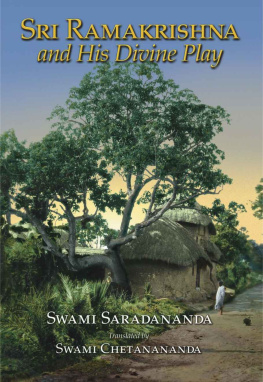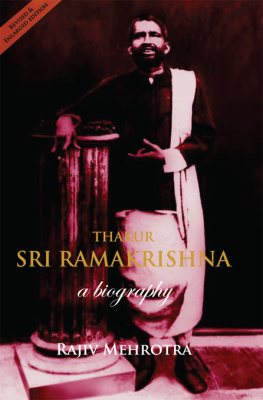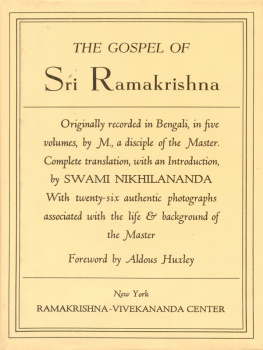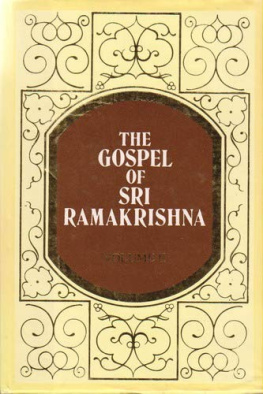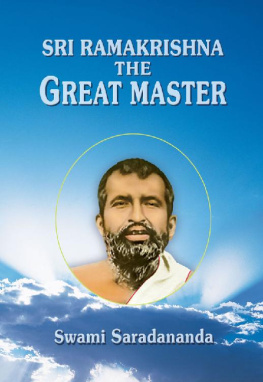



This book is dedicated - indeed, one may say it dedicates itself - to Swami Prabhavananda, head of the Vedanta Society of Southern California, my guru, dear friend and literary collaborator for the past twenty-five years. It was he who asked me to write it, and who has helped me with his advice and encouragement throughout the writing.
I owe great gratitude to Swami Madhavananda, head of the Ramakrishna Order, who read the manuscript chapter by chapter as it was sent to him at the Belur Math in Bengal, and supplied me with most valuable corrections, added information and comments.
From first to last, I have had constant help from John Yale (now Swami Vidyatmananda). While in India recently, he verified many details, collected illustrations for this book and compiled the explanatory notes on them which are printed in an appendix.
Here, at our centre in Los Angeles, I must also thank Swami Vanda- nananda, Ursula Bond (Pravrajika Anandaprana) and the many other members of the group who have shared in the work of this project.
C. I.
September, 1964
I
For notes on illustrations see page 339
Ramakrishna at Keshab's house frontispiece
i Studio portrait of Ramakrishna following page 46
2 Ramakrishna at Dakshineswar
3 Sarada Devi and Nivedita
4 Sarada Devi
5 Nahabat, Dakshineswar 98
6 Narendra: Swami Vivekananda
7 Rakhal: Swami Brahmananda
8 Group picture of disciples
9 Swami Turiyananda and Swami Premananda
io Swami Saradananda
i i Swami Shivananda
12 Swami Trigunatitananda 126
13 Swami Ramakrishnananda
i 4 Swami Adbhutananda and Swami Yogananda
15 Girish
16 M.
i 7 Mathur Nath Biswas
18 Keshab Sen and Brahmo followers 166
i 9 Death picture of Ramakrishna
20 Ramakrishna's birthplace, Kamarpukur
2 i Street scene, Kamarpukur
22 Map of Dakshineswar Temple 200
23 Ramakrishna's room, exterior
24 Ramakrishna's room, interior
25 Landing ghat, Dakshineswar
26 Image of Kali, front view 256
27 Image of Kali, side view
28 Old hackney carriage
29 Sword of Kali 282
30 Courtyard, Nat-mandap, and Kali Temple
31 Ramakrishna's signature
32 Panchavati
This is the story of a phenomenon.
I will begin by calling him simply that, rather than `holy man', `mystic', `saint', or `avatar'; all emotive words with mixed associations which may attract some readers, repel others.
A phenomenon is often something extraordinary and mysterious. Ramakrishna was extraordinary and mysterious; most of all to those who were best fitted to understand him. A phenomenon is always a fact, an object of experience. That is how I shall try to approach Ramakrishna.
Modern advertising has inflated our value-judgements until they are nearly worthless. Every product and person is said by its publicist to be the best. I want to avoid the competitive note here so I will say only this: Ramakrishna's life, being comparatively recent history, is well documented. In this respect, it has the advantage over the lives of other, earlier phenomena of a like nature. We do not have to rely, here, on fragmentary or glossed manuscripts, dubious witnesses, pious legends. What Ramakrishna was or was not the reader must decide for himself; but at least his decision can be based on words and deeds Ramakrishna indubitably spoke and did.
You will find a full bibliography at the end of the book. But I must also mention here the two great works which provide almost all of my source material. This book is really no more than an introduction to them, and I shall quote from them and paraphrase them throughout it. One is The Gospel of Sri Ramakrishna by M.; the other is Sri Ramakrishna the Great Master by Swami Saradananda. M. is the pseudonym of Mahendra Nath Gupta, the headmaster of a Calcutta high school, who first met Ramakrishna in 1882 and thereafter visited him regularly during the remaining four years of Ramakrishna's life. After each visit, M. noted down everything which had been said and done in his presence by Ramakrishna and those who were with him. The result is a very big book, which is probably close to totally accurate reporting. Saradananda was still in his teens when he met Ramakrishna and became his disciple. It was not until many years later that he began to write the articles which accumulated to form Sri Ramakrishna the Great Master, a biography which covers all of Ramakrishna's life except its last few months. Although Saradananda did not begin his work until more than twenty years after Ramakrishna's death, there is no doubt of its authenticity. Many of those who had known Ramakrishna were then still alive, and Saradananda carefully compared his memories with theirs. The Great Master has also the value of having been written by a monastic disciple, who has actually shared the extraordinary experiences he describes. `Nothing beyond my spiritual experience has been recorded in the book,' Saradananda once told a questioner. This seemingly cautious answer is in fact a claim so tremendous that it silences all suspicion of boastfulness; a man like Saradananda could not have made it unless it was literally true.




